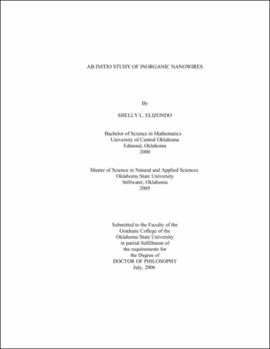| dc.contributor.advisor | Mintmire, John W. | |
| dc.contributor.author | Elizondo, Shelly L. | |
| dc.date.accessioned | 2013-11-26T08:26:31Z | |
| dc.date.available | 2013-11-26T08:26:31Z | |
| dc.date.issued | 2006-07 | |
| dc.identifier.uri | https://hdl.handle.net/11244/6885 | |
| dc.description.abstract | Scope and Method of Study: In this work, we report simulations of the electronic structure pertaining to two types of quasi-one-dimensional nanostructures: silver and zinc-oxide nanotubes and nanowires. The electronic structures were investigated within a first-principles, all-electron, self-consistent local density functional approach (LDF) adapted for helical symmetry. Two different approaches were used in modeling the silver structures: conventional helical geometry and strand-by-strand helical geometry. Within the silver study, we were particularly interested in energetic changes with respect to nanotube radius and the number of conduction channels related to the calculated band structures. Within the zinc oxide study, we were interested in the changes of optical properties in response to changes in nanotube diameter, and as such, the optical cross sections of the zinc-oxide nanotubes and nanowires are calculated using an Ehrenreich-Cohen formalism. | |
| dc.description.abstract | Findings and Conclusions: For the silver study, we found that the total energies of the nanotubes do not decrease monotonically as radius increases, as in carbon nanotubes. Within the strand-by-strand approach, we found that the total energy decreases inversely proportional to the number of strands, falling off further upon adding the last strand and thus completing the nanotube or nanowire structure. In addition, the number of conduction channels did not always correspond to the number of helical strands. For the zinc oxide study, all single-wall nanotubes were semiconducting with little variation in the band gap. The optical absorption spectra exhibited a fascinating trend. While the first peak associated with a direct transition stays relatively stationary, roughly 1.25 eV, as nanotube radius varies, the second optical peak resulting from a direct transition displays a blue-shift from 1.70 eV to 3.50 eV as nanotube radius decreases from 1.20 Å to 3.13 Å. The optical absorption spectra of the zinc oxide nanostructures proved very sensitive to even the smallest structural deformations. | |
| dc.format | application/pdf | |
| dc.language | en_US | |
| dc.rights | Copyright is held by the author who has granted the Oklahoma State University Library the non-exclusive right to share this material in its institutional repository. Contact Digital Library Services at lib-dls@okstate.edu or 405-744-9161 for the permission policy on the use, reproduction or distribution of this material. | |
| dc.title | Ab initio study of inorganic nanowires | |
| dc.contributor.committeeMember | Wilson, Timothy Michael | |
| dc.contributor.committeeMember | Westhaus, Paul A. | |
| dc.contributor.committeeMember | Materer, Nicholas | |
| osu.filename | Elizondo_okstate_0664D_1894.pdf | |
| osu.accesstype | Open Access | |
| dc.type.genre | Dissertation | |
| dc.type.material | Text | |
| thesis.degree.discipline | Photonics | |
| thesis.degree.grantor | Oklahoma State University | |
